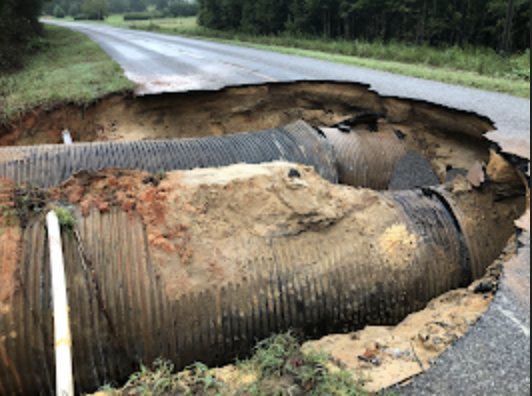Southern Pine Beetle damage is lighter than last year
Published 12:00 am Saturday, July 28, 2001
2000 was a devastating year for timber owners, due to damage from the Southern Pine Beetle (SPB), but this year appears to be better, according to officers of the Alabama Forestry Commission.
&uot;We went on flights back in June, but SPB activity was light, compared to last year,&uot; said Steve Perdue, ranger with the Alabama Forestry Commission. &uot;There are several factors that have made an impact on their (SPB) spread.&uot;
Perdue said the biggest factor has been the abundance of water this year.
&uot;Drought conditions put the pine trees into a stressed situation n without water, there was less sap for the trees to combat infestation with,&uot; he said. &uot;Coupled with educating the landowners on how to cut the beetle off.&uot;
Perdue said infestations unfortunately result in lost revenue from timber destruction.
&uot;The only way to get rid of the beetles is to cut a buffer zone around the infested stand of trees,&uot; he said. &uot;The most important part is actually cutting their path off.&uot;
Perdue said in June of 2000, SPB flights located 103 spots of infested timber, a larger amount than was seen this year.
&uot;In June of this year, we only saw 14 infestations,&uot; Perdue said.
&uot;But activity is picking up now n we are seeing more areas infested,&uot; said Forestry pilot Jimmy Mosley. &uot;We make flights everyday for SPBs until August n after that we have to split our flight time up, flying to locate forest fires.&uot;
Mosley uses state-of-the-art equipment to mark and track damage.
&uot;We use a GPS (Global Positioning Satellite) system to mark the infestation,&uot; he said. &uot;When we find a spot, the aircraft is positioned over it, and the position is recorded in the system's data bank n we later upload it to a computer, where it is transferred to a map.&uot;
It is at this point that rangers can determine the landowners, and contact them to advise them of the situation, and how to handle it.
He said that the new system is an outstanding asset, considering that before it was put in service, they had to manually mark maps as they flew.
&uot;It gives us more time to actually spot areas, instead of having to page through maps and mark them rapidly, before we have flown past them,&uot; Perdue said.
Perdue said although the year has started out light, the Forestry Commission is anticipating an increase in SPB activity before the summer is through.
&uot;Even though the number of SPB spots are considerably lower this year, we still have a lot of warm weather ahead of us n this will cause the activity to increase,&uot; Perdue said.
Perdue said landowners should still monitor their pine stands for signs of SPB infestation.
&uot;The most visible sign of a beetle problem appears when multiple trees have crown coloring that has changed to yellow or red, from its normal green appearance.&uot; Perdue continued, and a closer look at these dying trees will reveal snowy white-colored pitch tubes along the trunk of the tree; there will also be a brownish-white dust on the trunk and ground surrounding the base of the tree.&uot;
Perdue said pine trees get their nourishment from the roots, in the water they take in.
&uot;The water travels up the tree in the outer layers of the tree trunk,&uot; he said. &uot;And when the SPB bores its cut completely around the trunk of the tree, the flow of nourishment is cut off to everything above the cut.&uot;
Another factor that plays a role in SPB infestations is a slower harvest.
&uot;With the pulpwood industry slowed down right now, there are not as many stands of timber being cut, which just makes it easier for the beetle,&uot; Perdue said. &uot;We are seeing a great many more timber loading areas with logs still piled up in the woods, without any work nearby n this proves that the timber is not selling as well.&uot;
&uot;Today is our third flight in Butler County for the year,&uot; Mosley said. &uot;We have spotted new and increasing activity with each flight.&uot;
Perdue explained the flight process.
&uot;When we go on spotting flights, we start flying from one corner of the county to the other, making a two-mile wide pass each time,&uot; Perdue said. &uot;That gives us one mile to watch from both sides of the aircraft.&uot;
Perdue said a complete spotting flight takes approximately four hours to complete.
To eradicate an area of SPB infestation, Perdue said cutting is the only way.
&uot;The infested trees are already dead, it is just a matter of time before they will fall,&uot; Perdue said. &uot;What we recommend to landowners is that they cut a buffer surrounding the stand, taking some healthy, unaffected trees into the buffer zone.&uot;
Perdue said there are four stages, all marked by certain colors.
&uot;Trees that are needle-less, with a gray appearance are completely gone, they are dead,&uot; he said. &uot;The next color from the center is red, and this is a very active, but also devastating stage also.&uot;
Perdue said yellow coloring marks the travel of the beetle.
&uot;One area will appear yellow n this is the traveling direction of the beetles,&uot; Perdue said. &uot;A good rule of thumb we use is to recommend cutting the equivalent of the tallest infested tree's height into the unaffected trees, to create a barrier n SPBs are not good flying insects, and this will usually cut them off.&uot;


